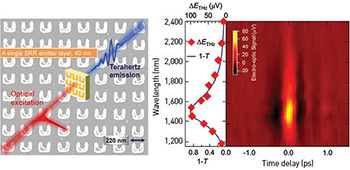 (Left) Broadband THz waves generated from split-ring-resonators (SRRs) by pumping the magnetic resonance of SRRs with 1,500 nm, 140 fs ultrafast laser pulse. The gray background patterns are electron micrograph of SRRs. (Right) A 2-D false-color plot of pump wavelength dependent THz generation. The THz field is dependent on the optical pump wavelength. On-resonance pumping at 1,500 nm gives rise to maximum THz emission. T is the measured transmission around the SRR’s magnetic-dipole resonance.
(Left) Broadband THz waves generated from split-ring-resonators (SRRs) by pumping the magnetic resonance of SRRs with 1,500 nm, 140 fs ultrafast laser pulse. The gray background patterns are electron micrograph of SRRs. (Right) A 2-D false-color plot of pump wavelength dependent THz generation. The THz field is dependent on the optical pump wavelength. On-resonance pumping at 1,500 nm gives rise to maximum THz emission. T is the measured transmission around the SRR’s magnetic-dipole resonance.
The terahertz (THz) spectral regime, ranging from about 0.1 to 15 THz, is one of the least explored yet most technologically transformative regions. For a long time, the lack of practical technologies to generate and detect THz waves made the THz regime inaccessible and labeled the “THz gap,” mainly due to the technical difficulties in making efficient THz emitters and detectors. Recent progress for generating and detecting THz waves is based on ultrafast laser pulses combined with field-resolved detection using nonlinear crystals.1 However, these crystals strongly absorb longitudinal optical phonon bands that lead to a gap in the THz spectrum in the Reststrahlen region. The crystals also create subtle quasi-phase-matching conditions that require locking phase velocity of THz waves to group velocity of the optical pump, which restricts the pump photon energy to a fixed and narrow range in order to increase the coherent length.
We recently designed a novel THz emitter that overcomes the above-mentioned limitations.2 It is based on artificial split-ring-resonator (SRR) metamaterials exhibiting optical magnetism. The highly efficient emitter is composed of a single layer of 40-nm-thick gold SRR film with a square lattice constant of 382 nm on a 1-mm-thick suprasil substrate. THz waves are generated exclusively from pumping the magnetic dipole resonance of the SRRs at 1,500 nm. Our results demonstrate THz bandwidth upto 4 THz that is limited only by the pump pulse duration of 140 fs.
The demonstrated second-order sheet nonlinear susceptibility of the SRR emitter is three orders of magnitude higher than the typical surface and sheet values of bulk crystals and thin films.2 The advantages of our approach are that the emitter does not suffer from the delicate quasi-phase-matching condition; it can be tailored to pump at any wavelength and can potentially generate a THz spectrum covering the entire THz range. The broadband THz spectroscopy sources demonstrated here create exciting opportunities to develop more practical THz technologies and to explore fundamental correlation physics in complex quantum materials.3
Researchers
Liang Luo, Ioannis Chatzakis, Jigang Wang, Thomas Koschny and Costas M. Soukoulis, Iowa State University and Ames Laboratory-USDOE, Ames, Iowa, USA
Fabian B.P. Niesler and Martin Wegener, Institute of Applied Physics, Institute of Nanotechnology and DFG-Center for Functional Nanostructures, Karlsruhe Institute of Technology, Karlsruhe, Germany
References
1. B. Ferguson et al. Nat. Mater. 1, 26 (2002).
2. L. Luo et al. Nat. Commun. 5, 3055 (2014).
3. T. Li et al. Nature 496, 69 (2013).
